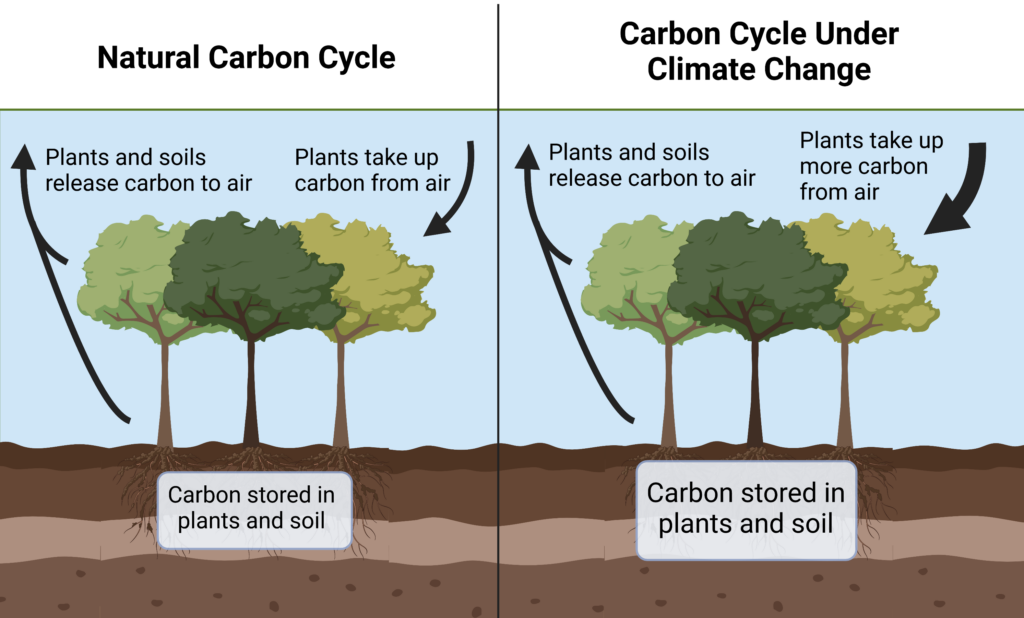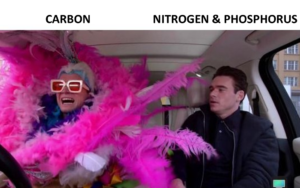Guest Post by Katherine Rocci, 2021-2022 Sustainability Leadership Fellow, and Ph.D. Candidate in the Department of Soil and Crop Sciences and the Graduate Degree Program in Ecology at Colorado State University
If you read about climate change in the news, you’re probably familiar with the element carbon. But carbon isn’t the only element associated with climate change. Nitrogen and phosphorus are two other elements with big, but undervalued, roles in understanding our future climate. Understanding the roles of nitrogen and phosphorus could be the difference of about 2.5°C/4.5°F of global warming (14 years of the anthropogenic emissions1)! Let me explain.
Carbon naturally moves through the environment. If we follow a single carbon molecule, we could expect it to start in the air as carbon dioxide. Carbon dioxide is food for plants and they take it into their bodies through a process called photosynthesis. That carbon could now be considered plant carbon, which could either be directly lost back to the air, as part of an energy-intensive process called respiration, or it could spend some time in the soil before going through respiration. This creates a cycle of carbon moving from the air, into plants and soil (i.e., the land), and then back to the air.
With climate change, we are changing this cycle. By pumping more carbon into the air, through the emission of fossil fuels, we are speeding up this cycle. For now, scientists have determined that approximately one-quarter of the carbon humans have put into the air has been taken up by the land (photosynthesis > respiration). This means we are not feeling the worst effects of climate change thanks to the plants and the soil! However, scientists are not sure if this trend will continue.

This is where nitrogen and phosphorus come in! Perhaps you’ve heard of nitrogen and phosphorus, as they are some of the elements required for life. Growing up in New Hampshire, I learned these elements as NH-COPS (nitrogen, hydrogen, carbon, oxygen, phosphorus, and sulfur), although I’m sure you learned a different acronym. Nevertheless, this acronym tells us that nitrogen and phosphorus are required for all living things, including plants. In fact, for every 394 carbon’s, an average plant leaf needs 13 nitrogen’s and 1 phosphorus2, although this varies a lot between plant types.
Much like us humans, plants need nitrogen for amino acids, which make the proteins that give them structure. However, unlike us, most nitrogen in plants is used for the production of a very special protein called RuBisCo. RuBisCo speeds up photosynthesis, directly allowing plants to take up carbon from the air. Similarly, phosphorus is needed for general protein production and is also key for plant energy transformations, making it an important element for both carbon absorption (photosynthesis) and carbon loss (respiration).
So, the big question is: will there be enough nitrogen and phosphorus to keep plants sucking carbon out of the air? If not, we may feel the effects of climate change much more strongly than we currently do. Luckily, many brilliant scientists are working on this problem (e.g., 3,4).
Besides adding carbon to the air, human activity also adds extra nitrogen to the air. That nitrogen travels through the air and falls on land, adding extra nitrogen where it would not normally be. So, could this nitrogen falling from the sky allow the land to keep absorbing carbon? Probably not. A recent study found that human-induced added nitrogen can only provide about 1% of the carbon storage in forests5 and so will likely not play a big role in promoting future land uptake of carbon.
Another consequence of adding carbon to the air is a global increase in temperatures. This occurs because carbon dioxide is really good at capturing radiation and reflecting it back to the Earth, causing the Earth to warm up. This warming could lead to enhanced activity of bugs in the soil that breakdown dead plant material. When these bugs breakdown dead plant material, they release nitrogen and phosphorus in forms that plants can then use to grow. So, could warming-induced increases in nitrogen and phosphorus in the soil allow the land to keep taking up carbon? Maybe. Simple representations of this warming induced increase in soil nitrogen availability could theoretically allow for carbon to continue to be taken up by plants at its current rate1. However, this has not been shown for phosphorus, for which there is much less data.

What does all this mean for future climate? Presently, we are not certain whether plant uptake of carbon will continue to reduce the effects of climate change on our world or whether nitrogen and phosphorus will limit this plant uptake. Fortunately, groups like the INCyTE research coordination network, funded by the National Science Foundation are motivated to answer this question. So, hopefully we’ll have some clearer answers soon. Until then, I hope when you think climate change, you don’t just think carbon, but keep in mind nitrogen and phosphorus as well.
1 Wieder, W. R., Cleveland, C. C., Smith, W. K. & Todd-Brown, K. Future productivity and carbon storage limited by terrestrial nutrient availability. Nature Geoscience 8, 441-444 (2015).
2 Tang, Z. et al. Patterns of plant carbon, nitrogen, and phosphorus concentration in relation to productivity in China’s terrestrial ecosystems. Proceedings of the National Academy of Sciences 115, 4033-4038 (2018).
3 Finzi, A. C. et al. Responses and feedbacks of coupled biogeochemical cycles to climate change: examples from terrestrial ecosystems. Frontiers in Ecology and the Environment 9, 61-67 (2011).
4 Huang, Y., Wang, Y. P. & Ziehn, T. Nonlinear interactions of land carbon cycle feedbacks in Earth system models. Global Change Biology (2021).
5 Schulte‐Uebbing, L. F., Ros, G. H. & de Vries, W. Experimental evidence shows minor contribution of nitrogen deposition to global forest carbon sequestration. Global Change Biology (2021).






